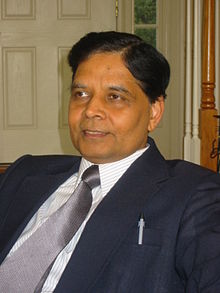 Money makes money, and the more money that money makes, makes more money—Benjamin Franklin
Money makes money, and the more money that money makes, makes more money—Benjamin Franklin
John Maynard Keynes was the most influential economist of the twentieth century. Keynes really came into his own in 1936, when his magnum opus The General Theory of Employment, Interest and Money was published.
One of the core points of the book was that when it came to thrift or saving, the economics of the individual differed from the economics of the entire system. For an individual to save by cutting down on expenditure made tremendous sense. But when a society, as a whole, began to save more, there was a problem.
This was because the expenditure of one person was the income for another. Hence, when expenditure began to go down, incomes would fall too, leading to a further reduction in expenditure. And so the cycle would continue. The aggregate demand of a society as a whole would fall in the end, leading to either lower prices or lower production or both, thus impeding economic growth and causing economic contraction.
As per Keynes, the way out of this situation was for someone to spend more. Citizens and businesses were not willing to spend more, given the state of the economy. So, the only way out of this situation was for the government to spend more on public works and other programs. This would act as a stimulus and thus cure the recession.
This has been standard prescription given by economists when countries are not doing well. Having said that the basic idea put forward by Keynes had been known for a very long time. Even Roman kings had practised it.
As Kabir Sehgal writes in Coined—The Rich Life of Money and How Its History Has Shaped Us: “Julius Caesar left his stamp on Roman monetary history by using the gold treasure he pillaged from Gaul to increase the quantity of the aureus in circulation…These new coins helped Rome cope with a financial crisis of 49BC.” So, even Julius Caesar had used Keynes’ prescription of increasing government spending during recessionary times and thus helped revive the economy.
Caesar’s successor Augustus followed the same prescription in order to revive the Roman economy when it was suffering from a depression, during the course of his rule. As Sehgal writes: “Augustus used loot captured from Egypt to spend lavishly on civil projects and enhanced welfare programs…In time…the economy recovered.”
Interestingly, the rulers that followed Julius and Augustus, followed their model. One such ruler was Nero who ruled Rome between AD 54 and AD 68 and had to face a depression in AD 62. In AD 64, a fire blazed through Rome and this created further problems. But Nero got through this by increasing “food subsidies for the public” and “spending on civil projects like canals”.
But along with following the Keynesian model, Nero did something else as well. He started reducing the quantity of metal in the Roman coins. Nero reduced the silver content of denarius (a silver coin) by 10%. He also reduced the gold content of the aureus by 10 percent in AD 64. By reducing the metal content in coins Nero was able to produce more coins. In the modern sense, he was thus able to increase money supply by around 7%.
What was the idea behind this debasement of metallic money? “The story goes that with more money flowing through the economy, prices will rise to reflect the reduced value of the currency, which will spur individuals and businesses to spend now rather than later, leading to a bump in economic activity,” writes Sehgal.
Nero was the not the first ruler to practice this strategy. Neither was he the last one. This is a practise that has been regularly resorted to by kings, queens, dictators, general secretaries, and politicians ever since.
In fact, Nero couldn’t have gone about it as well as politicians and central bankers do, in this day and age. The reason for this lies in the fact that during Nero’s time Rome used gold and silver coins as money. As Sehgal writes: “Nero was unable to affect uniformly his entire currency at once. When he issued a new batch of debased coins[i.e. coins with lower metal content] there were still high-grade coins{i.e. the coins that had been issued earlier and had a higher amount of metal content in them] in circulation. The value of these high-grade coins would appreciate, yet it would take time for them to be hoarded and removed from circulation.” They would be hoarded because they had more metal in them than the new coins.
But with paper money there are no such problems. When a central bank issues more paper money it “adjusts the overall money supply” and “affects the value of all notes simultaneously”. “Today it’s still common practice for central banks to adjust the supply of money to abet political goals,” writes Sehgal.
Take the case of Bank of Japan—the Japanese central bank is mandated to print 80 trillion yen annually so that it can create some inflation in Japan and get people to spend money (as explained above) and in the process create some economic growth. The idea also is to drive down the value of the yen against other currencies so that Japanese exports pick up. A paper money system gives the government and the central bank this kind of flexibility. This is something that would not be easily possible in a metallic based system. In order to flood the financial system with more gold or more silver, more gold or silver would be required. Unlike paper money, metallic money cannot be created out of thin air.
Also, history has shown that debasement of currency leads to inflation as more and more money chases the same amount of goods and services. And inflation benefits borrowers as they repay money they had borrowed with money that is less valuable than it was before. Further, governments run by politicians are themselves big borrowers. Hence, inflation ends up benefiting governments as well.
It is much easier to create inflation with a paper money system than with metal based currencies. In fact, a few years back I spoke to Russell Napier of CLSA who made a very interesting point: “The history of the paper currency system, or the fiat currency system is really the history of democracy… Within the metal currency, there was very limited ability for elected governments to manipulate that currency. And I know this is why people with savings and people with money like the gold standard. They like it because it reduces the ability of politicians to play around with the quantity of money. But we have to remember that most people don’t have savings. They don’t have capital. And that’s why we got the paper currency in the first place. It was to allow the democracies. Democracy will always turn toward paper currency and unless you see the destruction of democracy in the developed world, and I do not see that, we will stay with paper currencies and not return to metallic currencies or metallic based currencies.”
And this best explains why politicians love paper money.
The column originally appeared on The Daily Reckoning on April 16, 2015


